
- ONCOLOGY Vol 15 No 3
- Volume 15
- Issue 3
Preliminary Report of Rituximab With Intensive Chemotherapy for Untreated Aggressive Mantle Cell Lymphoma
Mantle cell lymphoma (MCL) has a low complete response (CR) rate (21%) after anthracycline-containing regimens, a short duration of response (median: 10 months), and dismal survival (median: 2 to 4 years). This improves to 100% after
Mantle cell lymphoma (MCL) has a low complete response (CR) rate (21%) after anthracycline-containing regimens, a short duration of response (median: 10 months), and dismal survival (median: 2 to 4 years). This improves to 100% after hyper CVAD (cyclophosphamide [Cytoxan, Neosar], vincristine/doxorubicin [Adriamycin], dexamethasone) alternating with high-dose methotrexate and ara-C (hyper CVAD/M-A) consolidated with high-dose chemotherapy with stem cell rescue and total-body irradiation (HDCT-SCT/TBI) (J Clin Oncol 16:3803, 1998).
In this study, seven patients did not receive transplant because of financial reasons, inability to harvest stem cells, or refusal. Instead, they received up to eight cycles of hyper CVAD/M-A, achieving CR after six cycles. Because of this, we are currently investigating eight alternating cycles of hyper CVAD/M-A in previously untreated patients but without consolidation with HDCT-SCT/TBI unless a CR is not achieved after the first six cycles of treatment. We have included rituximab (Rituxan) at 375 mg/m2 given 24 hours before each of the first six cycles of therapy. Infection prophylaxis was as in the previous report.
As of July 2000, 43 patients have been entered in the study and 37 are eligible for response. Of these, 1 died after cycle 2 (M-A) for unclear reasons. The remaining 36 patients all responded, making the response rate 97%. Eight of these achieved partial response (PR) and are still responding to therapy, 1 achieved a stable PR, and 27 are in either CR (24 patients) or CRu (3 patients). A total of 29 patients have completed at least 6 cycles, 28 of whom (97%; one death) have achieved a response and 26 of whom (90%) are complete responders. Of the two partial responders, one patient is over 65 years old and, by protocol requirements, received only one-third of the ara-C dose. The other patient had stable partial response but refused consolidation with HDCT-SCT/TBI and is now progressing.
With a median follow-up of 8 months, 2/37 (5%) patients have failed (one death, one PR who progressed). This contrasts with 14/28 (50%) relapse rate at 8 months median follow-up for the historical CHOP (cyclophosphamide, doxorubicin HCl, vincristine [Oncovin], prednisone) control group (P = .001), and is comparable to the failures for the transplanted group in the prior study at 8 months of follow-up (4%). As expected, hematologic toxicity was severe but only 8% of patients developed grade 3 infection and none developed grade 4 infection by National Cancer Institute criteria.
CONCLUSION: Our results are encouraging and the trial continues to accrue patients.
Articles in this issue
over 24 years ago
State of the Art of Non-Small-Cell Lung Cancer in the New Millenniumover 24 years ago
Novel Approaches in the Treatment of Non-Small-Cell Lung Cancerover 24 years ago
Triplet Combination Chemotherapy and Targeted Therapy Regimensover 24 years ago
Gemcitabine for the Treatment of Non-Small-Cell Lung Cancerover 24 years ago
Gemcitabine in Combination With New Platinum Compounds: An Updateover 24 years ago
Treatment of Elderly Patients With Non-Small-Cell Lung Cancerover 24 years ago
Irinotecan in Gastrointestinal MalignanciesNewsletter
Stay up to date on recent advances in the multidisciplinary approach to cancer.






















































































